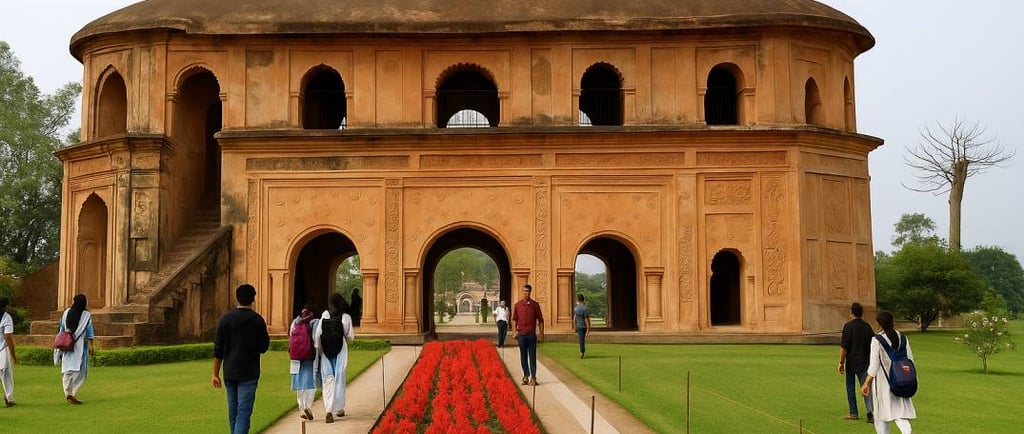Sivasagar, Assam: Ancient Temples, Palaces & Ahom Heritage
Plan your trip to Sivasagar, Assam and explore its impressive historical sites like Siva Dol, Talatal Ghar, and Rang Ghar. Delve into the fascinating legacy of the Ahom dynasty.
ASSAM


Settled in the lush plains of Upper Assam, Sivasagar is more than just a town; it's a living testament to a glorious past, a repository of architectural marvels, and a vibrant cultural hub. Once the mighty capital of the Ahom kingdom, which ruled Assam for over six centuries, Sivasagar (formerly known as Rangpur) invites travelers to step back in time and uncover the tales of a powerful dynasty that shaped the region's identity.
Historical Background: The Ahom Legacy
The story of Sivasagar is inextricably linked with the Ahom kingdom. The Tai-Ahoms, led by Sukaphaa, migrated from present-day Myanmar in the 13th century and established their rule in the Brahmaputra Valley in 1228 CE. Over the next 600 years, they forged a formidable empire, successfully repelling numerous invasions, including those by the mighty Mughals.
Sivasagar served as the Ahom capital from 1699 to 1788. It was during this period that the town flourished as a center of governance, culture, and spirituality. The Ahom kings and queens, known for their administrative prowess and architectural vision, left behind an impressive legacy of temples, palaces, and tanks that continue to stand tall, narrating stories of a bygone era.
The name "Sivasagar" itself has historical roots. In 1733, Ahom queen Ambika Devi, wife of King Siva Singha, excavated a massive tank, covering an area of 257 acres. This magnificent water body, also known as Borpukhuri, was dedicated to Lord Shiva and came to be known as "Sivpore" (Sivpur), eventually evolving into Sivasagar.
Relevance and Why it's Famous
Sivasagar's fame stems from its unparalleled historical and architectural significance. It's a pilgrimage site for history enthusiasts and a delight for anyone seeking to understand the rich heritage of Northeast India.
Architectural Grandeur: The Ahom rulers were master builders, and Sivasagar showcases their engineering and artistic skills. The structures here are unique, blending indigenous techniques with influences that resulted in distinct architectural styles.
Ahom Kingdom's Heart: As the erstwhile capital, Sivasagar was the nerve center of the Ahom kingdom. It was from here that the kings administered their vast territory, held court, and celebrated their victories. Visiting Sivasagar is like stepping into the very heart of this powerful empire.
Cultural Hub: Even today, Sivasagar pulsates with the rich Assamese culture. Festivals like Mahashivaratri at the Shiva Dol and Rongali Bihu are celebrated with immense fervor, offering a glimpse into the local traditions and way of life.
Why Visit Sivasagar? Major Attractions
A trip to Sivasagar is a captivating journey through time. Here are some of the must-visit attractions:
Sivasagar Tank (Borpukhuri): This massive artificial lake is the centerpiece of the town and a marvel of ancient engineering. Its water level remains consistent throughout the year, a testament to its sophisticated design. On its banks stand three prominent temples:
Siva Dol: Dedicated to Lord Shiva, this towering temple (104 feet tall) is believed to be one of the tallest Shiva temples in India and attracts large crowds, especially during Mahashivaratri.
Vishnu Dol: A temple dedicated to Lord Vishnu, reflecting the religious diversity nurtured by the Ahom rulers.
Devi Dol: Sacred to Goddess Durga, showcasing the reverence for feminine divinity.
Rang Ghar: Often called the "Colosseum of the East," Rang Ghar is Asia's oldest amphitheater. Built by King Pramatta Singha in 1746, this unique two-storied pavilion with an egg-shaped dome served as the royal sports arena where Ahom kings and nobles watched events like buffalo fights and other cultural performances.
Talatal Ghar: This seven-storied palace was a strategic stronghold for the Ahoms. With three underground floors (Talatal Ghar) and four above-ground floors (Kareng Ghar), it boasts secret tunnels, including one believed to lead to the Dikhow River and another to the Gargaon fortress. It's a fascinating example of Ahom military architecture.
Kareng Ghar (Gargaon Palace): Located near Sivasagar, the Gargaon Palace was an earlier capital of the Ahom kingdom. This grand structure, built by King Suklengmung in 1540, showcases the royal living quarters and offers further insights into Ahom architecture.
Charaideo Maidam: Approximately 28 kilometers from Sivasagar, Charaideo is the original capital of the Ahom kingdom established by Sukaphaa. It is famous for its "Maidams," which are royal burial mounds resembling the pyramids, preserving the remains of Ahom kings and queens. These structures offer a unique blend of indigenous and Mughal architectural styles.
Joysagar Tank and Temples: Built by King Rudra Singha in 1697 to commemorate his mother Joymoti, this massive man-made lake also has temples on its banks.
Ahom Museum: For those eager to delve deeper into the Ahom dynasty's history, the Ahom Museum houses a rich collection of artifacts, including royal armory, clothes, manuscripts, and more, offering a comprehensive glimpse into their culture and lifestyle.
Best Time to Visit
The ideal time to visit Sivasagar is during the winter months, from October to February. The weather during this period is pleasantly cool and dry, with temperatures ranging from 10°C to 25°C, making it perfect for sightseeing and outdoor exploration.
Avoid: The monsoon season (July to September) brings heavy rainfall and high humidity, which can hinder travel and outdoor activities. Summers (March to June) can be hot and humid, with temperatures soaring.
What we can conclude?
Sivasagar is a destination that captivates the imagination and transports visitors to a glorious past. Its imposing monuments, serene tanks, and vibrant culture offer a unique blend of history, architecture, and natural beauty. For anyone interested in uncovering the untold stories of a powerful kingdom that once thrived in Northeast India, Sivasagar is an absolute must-visit. It's a journey into the soul of Assam, a reminder of the resilience, innovation, and spiritual depth of the Ahom civilization. So, pack your bags and prepare to be enchanted by the timeless tales of Sivasagar!
Read also: Top 10 Places in Assam
